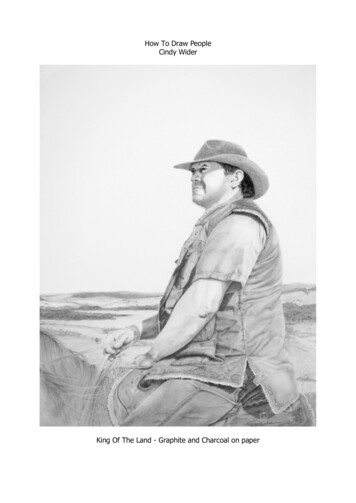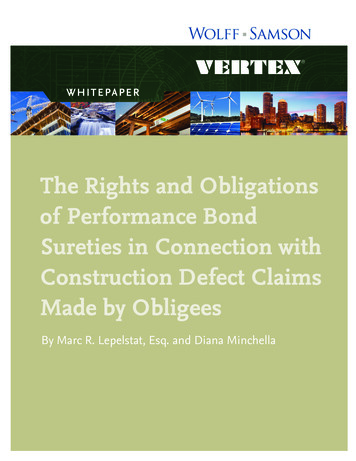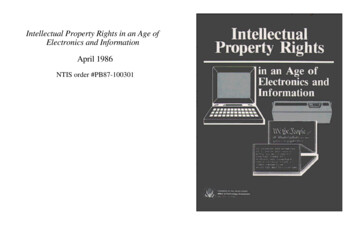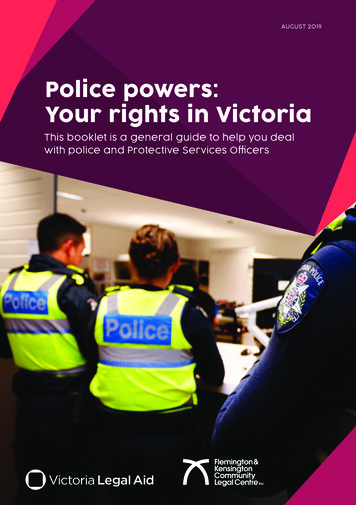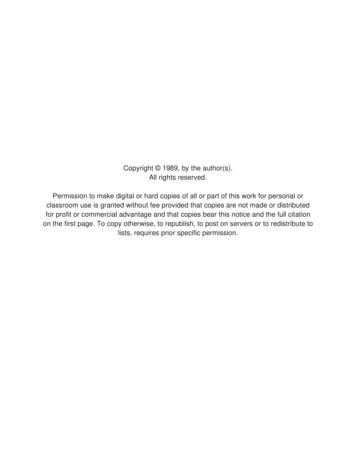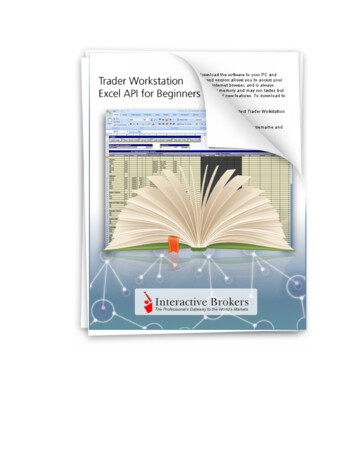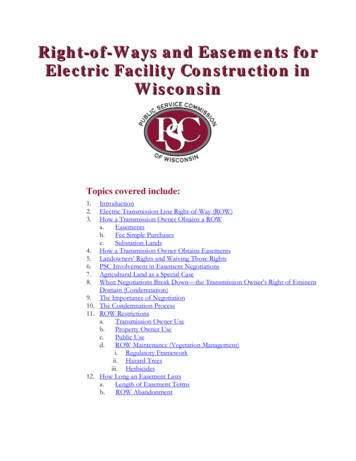
Transcription
Right-of-Ways and Easements forElectric Facility Construction inWisconsinTopics covered include:1.2.3.IntroductionElectric Transmission Line Right-of-Way (ROW)How a Transmission Owner Obtains a ROWa.Easementsb.Fee Simple Purchasesc.Substation Lands4. How a Transmission Owner Obtains Easements5. Landowners’ Rights and Waiving Those Rights6. PSC Involvement in Easement Negotiations7. Agricultural Land as a Special Case8. When Negotiations Break Down—the Transmission Owner’s Right of EminentDomain (Condemnation)9. The Importance of Negotiation10. The Condemnation Process11. ROW Restrictionsa.Transmission Owner Useb.Property Owner Usec.Public Used.ROW Maintenance (Vegetation Management)i. Regulatory Frameworkii. Hazard Treesiii. Herbicides12. How Long an Easement Lastsa.Length of Easement Termsb.ROW Abandonment
IntroductionThe Public Service Commission of Wisconsin (PSC or Commission) offers this overview to landownerswho must negotiate easement contracts with transmission owners for new electric transmission lines or salesof land for substations. It explains the easement process so that landowners may have informednegotiations with transmission owners. Transmission owners are a type of utility company that moveelectricity from generation sites to distribution lines. Their easement agreements and management ofrights-of-way (ROW) are likely to differ from local electric or gas utilities.The Commission understands that there are concerns among landowners about the eminent domainprocess (condemnation). The procedures of eminent domain are addressed in this overview, but a morecomplete discussion is contained in a publication from the Wisconsin State Energy Office entitled, “TheRights of Landowners under Wisconsin’s Eminent Domain Law.” 1 Because easement agreements areprivate contracts, the PSC does not participate in the negotiations between transmission owners andlandowners. The processes for negotiation and condemnation are covered by the laws in Chapter 32 of theWisconsin Statutes.This overview explains what a transmission ROW is and how a transmission ownernormally obtains the ROW it needs to build and protect its facilities. It also explainsthe relationship between initial contract negotiations and the eminent domain process.Finally, it discusses some concerns about landowner rights and easement contracts. 2 Ifeasement negotiations for an easement between a transmission owner and a landownerfail and the condemnation process begins, the landowner should review the “Rights ofLandowners” state publication.Electric Transmission Line ROWFigure 1 TypicalTransmission owners are the entities that own and maintain electricity transmissionVertical MonopoleStructurefacilities. An electric transmission line ROW is a strip of land that an electrictransmission owner uses to construct, maintain, or repair a large power line. Its use isgoverned by a private business contract, called an easement, between the transmission owner and thelandowner. If the transmission owner needs access roads to get to the power line ROW, it also obtainseasements for those access roads.A transmission line ROW is wider than a ROW for a smaller distribution line that serveshomes and businesses directly. Transmission lines may operate at several hundredthousand volts and can serve several hundred thousand customers. Distribution linesoperate at several thousand volts and can serve a few thousand customers. A serviceconnection to a home operates at a few hundred volts.Figure 2 Typical HFrame StructureA transmission line is usually centered in the ROW. The structures (usually poles and crossarms) keep the wires away from the ground, other objects, and each other. Structureheight, type, span length (distance between structures), and ROW width are interrelated. Iflandowners wish to have fewer transmission structures installed on their land, they mightask if a longer span length is possible. To increase the span length, the transmission owner“The Rights of Landowners under Wisconsin’s Eminent Domain Law.” Wisconsin State Energy .asp?docid 22817&locid 160)2 Wisconsin utilities have appeared to change their approaches to easement contracts and ROW vegetation management since thecreation of the National Electric Reliability Corporation (NERC) in 2007.12
might need to increase the structure height. If the span length and height are greatly increased, a widerROW is sometimes needed.Sometimes it is necessary to attach distribution lines (distribution underbuild) to transmission line structures.This would limit the transmission span length to maintain safe clearances below the distribution line.Distribution lines along transmission routes are often buried with the transmission lines remaining aboveground.How a Transmission Owner Obtains a ROWA transmission owner obtains a ROW for an electric transmission line or substation through the purchaseof an easement (purchasing rights to the land) or fee title ownership (purchasing the land).EasementsThe most common arrangement for a transmission owner to obtain land rights is an easement. When atransmission owner seeks an easement, a real estate agent contacts a landowner to negotiate the purchase ofusage rights for a specific parcel or strip of land that is to be used for the power line.An easement between a transmission owner and a landowner is a legal contract that allows the transmissionowner to build, maintain, and protect the power line. The landowner retains general ownership of the landand pays the taxes on the parcel. The landowner sells the usage rights to the transmission owner for anegotiated amount of money, generally paid in one lump sum. The contract specifies restrictions on boththe transmission owner’s and the landowner’s use of the land and specifies the rights of the transmissionowner. It is binding upon the transmission owner, the landowner, and any future owners of the land untilthe contract is dissolved. Future owners of the land should find the easement contract attached to the deed.Sometimes, a new line needs to be installed in place of an older line that is in poor condition. If theexisting ROW is not appropriate for the new line, a new ROW must be obtained through a new easement.Under Wis. Admin. Code § PSC 113.0509(2), new transmission easements must specify the: (1) type, heightlimits, and number of new structures; (2) line voltage; and (3) ROW width.If the existing ROW and structures are still appropriate but the original easement can be improved in otherways, the transmission owner may offer to renegotiate the easement contract. For example, some oldereasements have wording that is difficult to interpret or a legal description that refers to an entire 40-acreparcel for the ROW when only a 60-foot-wide strip is needed. The transmission owner may ask torenegotiate a contract when rebuilding an old line on existing ROW in order to clarify its relationship withthe affected landowner.Fee Simple PurchasesAnother arrangement for obtaining new power line ROWs is for the transmission owner to actuallypurchase the land. In this arrangement, the landowner sells the strip of land to the transmission owneroutright, and the utility owns the ROW in fee simple. In this situation, the landowner gives up ownership ofthe land along with all the rights and responsibilities that ownership entails. This is a common arrangementfor new substations, but is rarely used when siting transmission lines.Substation LandsTransmission substations vary in size because of the different numbers of lines and different size lines andtransformers in each one. A simple distribution substation may require less than one acre, while a large3
substation may require six acres or more. Some land outside the substation fence may be needed for accessroads. If landscaping or earthen berms are used to screen the substation, more land may be necessary. Ifmore land is purchased than is needed for the substation, the utility may sell the excess land, rent it out forfarming or other local uses, or retain it for potential substation expansions.How a Transmission Owner Obtains EasementsA transmission owner acquires easements by negotiating with landowners on whose lands the power linewill be constructed. Easement negotiations begin at different times, depending on the type of project andthe type of approval the transmission owner must receive from the Commission. A transmission ownermust receive a Certificate of Public Convenience and Necessity (CPCN) from the Commission for atransmission project that is either: (1) 345 kilovolts (kV) or greater; or (2) less than 345 kV but greater than100 kV, over one mile in length, and needing new ROW.A transmission owner must receive a Certificate of Authority (CA) for any transmission line it proposes ofany voltage if the proposed cost exceeds a cost threshold related to the transmission owner’s size.According to Wisconsin’s eminent domain law (Wis. Stat. § 32.03(5)), a transmission owner generally maynot acquire an easement for transmission projects requiring a CPCN until it receives the CPCN from theCommission. The Commission determines the transmission line route and structure designs that should beused after reviewing the record of the public hearing for the CPCN. However, Wis. Stat. § 32.03(5)(c) doesallow a transmission owner to negotiate an easement with a landowner before a CPCN is issued if thetransmission owner advises the landowner that it doesn’t have authority to acquire the property bycondemnation until the CPCN actually is issued.For lower voltage lines where a CA is required, there may be only one proposed route and structure type.For these types of proposed construction cases, the transmission owner may begin easement negotiationsbefore the CA has been granted by the Commission.Although the negotiation for an easement is a private transaction between the transmission owner and thelandowner, a formal process protects a landowner’s rights during the negotiation. In a typical negotiation, atransmission owner’s agent presents a landowner with a draft easement and an estimate of the value of theROW it wants to purchase. The landowner has the right to have his or her own appraisal made by aqualified appraiser. The reasonable cost of this appraisal must be reimbursed by the transmission owner if:(1) it is submitted to the utility within 60 days after receipt of the utility’s appraisal; and (2) it meets thestandards of the law in Wis. Stat. § 32.09.The easement between a transmission owner and an individual is specific to the land in question and eacheasement differs depending on many factors. The landowner should not sign an easement without firstreading it, asking questions, and negotiating. Under Wis. Admin. Code § PSC 113.0509, the landowner shallhave a minimum period of five days to review the proposed easement, unless this period is voluntarilywaived by the landowner. Also, there is nothing barring one landowner along a proposed transmission routefrom discussing easement concerns with other landowners before signing. As stated earlier, in the case ofhigh-voltage transmission lines, Wis. Admin. Code § PSC 113.0509(2) states that the easement contract musthave certain descriptive details about the line: Length and width of the ROW.Number, type, and maximum height of all structures to be erected on that ROW.Minimum height of the transmission lines above the landscape.Number and maximum voltage of the lines to be installed on that ROW.4
For a newly proposed project, the landowner may also examine the project application that the transmissionowner submitted to the PSC for review. For projects that require a CPCN, the PSC ensures that copies ofthe application are provided to the clerk of each municipality and town in the project area and also to themain public library in each county in the project area. Interested persons can also request copies of theapplication directly from the transmission owner or review it on the PSC’s Electronic Regulatory Filing(ERF) system web site (http://psc.wi.gov). All documents for proposed construction cases can be accessedon the PSC’s website by using a project application’s unique PSC docket number. More information aboutusing the PSC’s ERF system can be found on the web site or by contacting the PSC Division of EnergyRegulation at (608) 266-5481.Landowners’ Rights, and Waiving Those RightsWisconsin law lists some rights of landowners whose properties will be affected by a transmission line thatis 100 kV or larger and over one mile in length. Table 1 lists these rights. The landowner may be asked towaive, or give up, one or more of these rights, but does not have to do so. In the easement, marked orcrossed-out items in the list are “waived” or no longer applicable if the landowner signs the easement. Theeasement should not be signed unless the landowner absolutely agrees to waive the items as indicated.Easements are legally binding and should be written in precise language. The landowner’s rights listed inTable 1 are generally included as part of the easement by being attached as an “Exhibit.” A term of theeasement might state that those rights that are listed, marked, or crossed out in the exhibit would be“waived,” i.e., not included in the easement. Table 2 gives an example of easement language that one mightsee for waiving landowner rights. (The “Grantor” is the landowner and the “Grantee” is the utility, in thiscase a transmission owner).Waiving any of these rights, as well as any other part of the contract not required by law, is negotiable andnot an obligation.5
Table 1Landowners’ RightsLandowners who sign an easement with the utility have the specific rights provided under the WisconsinStatutes. These rights are applicable for high voltage power lines that are 100 kV or larger, longer thanone mile, and built after 1976. If landowners have questions or problems related to these rights, theyshould contact the PSC at (608) 266-5481 or (888) 816-3831.Under Wisconsin law (Wis. Stat. § 182.017(7)(c) to (h)), the rights are expressed as utility requirements:(c)In constructing and maintaining high-voltage transmission lines on the property covered bythe easement the utility shall:1(d)(e)(f)(g)(h)If excavation is necessary, ensure that the top soil is stripped, piled and replaced uponcompletion of the operation.2. Restore to its original condition any slope, terrace, or waterway which is disturbed bythe construction or maintenance.3. Insofar as is practicable and when the landowner requests, schedule any constructionwork in an area used for agricultural production at times when the ground is frozen inorder to prevent or reduce soil compaction.4. Clear all debris and remove all stones and rocks resulting from construction activityupon completion of construction.5. Satisfactorily repair to its original condition any fence damaged as a result ofconstruction or maintenance operations. If cutting a fence is necessary, a temporarygate shall be installed. Any such gate shall be left in place at the landowner’s request.6. Repair any drainage tile line within the easement damaged by such construction ormaintenance.7. Pay for any crop damage caused by such construction or maintenance.8. Supply and install any necessary grounding of a landowner’s fences, machinery orbuildings.The utility shall control weeds and brush around the transmission line facilities. Noherbicidal chemicals may be used for weed and brush control without the express writtenconsent of the landowner. If weed and brush control is undertaken by the landownerunder an agreement with the utility, the landowner shall receive from the utility a reasonableamount for such services.The landowner shall be afforded a reasonable time prior to commencement of constructionto harvest any trees located within the easement boundaries, and if the landowner fails todo so, the landowner shall nevertheless retain title to all trees cut by the utility.The landowner shall not be responsible for any injury to persons or property caused by thedesign, construction or upkeep of the high-voltage transmission lines or towers.The utility shall employ all reasonable measures to ensure that the landowner’s televisionand radio reception is not adversely affected by the high-voltage transmission lines.The utility may not use any lands beyond the boundaries of the easement for any purpose,including ingress to and egress from the right-of-way, without the written consent of thelandowner.6
Table 2Examples of Easement Contract Language that Waive Certain Landowner RightsIn the Contract:“The parties hereto do hereby agree to the terms and conditions set forth in Exhibit(s) ,attached hereto and incorporated therein.”At the top of the Exhibit:“As part of the foregoing High Voltage Electric Line Easement, Grantor(s) do herebyspecifically waive certain of the following rights as designated at the bottom hereof . . .”At the Bottom of the Exhibit:“The Grantor(s) do hereby waive the rights provided in the following paragraphs of thisExhibit A . . .” [with spaces following for listed rights to be waived]PSC Involvement in Easement NegotiationsAn easement is a private agreement between the landowner and the transmission owner. The PSC,therefore, cannot become involved in easement negotiations.Agricultural Land as a Special CaseAgricultural land presents a special case. A negotiation tool that may be available to farm operators orfarmland owners is the Agricultural Impact Statement (AIS) prepared for certain power line projects by theWisconsin Department of Agriculture, Trade, and Consumer Protection (DATCP). Any power line orsubstation that involves taking an interest in over five acres from any single farm operation requirespreparation of an AIS before easement or purchase contract negotiations can begin. A “farm operation” isdefined by law as an activity conducted primarily for the production of commodities for sale or home use insuch quantity that the commodities contribute materially to the support of the farm operator.Even if the taking is less than five acres, DATCP may decide to prepare an AIS if it believes the acquisitionwill have a significant effect on farm operations. The completed AIS is sent to affected farmland ownersand farm operators. By law, DATCP must also distribute copies to certain local municipal offices andlibraries in the potentially affected area. The transmission owner is not allowed to negotiate with theproperty owner or begin condemnation for at least 30 days after publication of the AIS. (For more oncondemnation, see discussion below.)According to Wisconsin law (Wis. Stat. § 32.09(6r)), if the transmission line is at least 100 kV and more thanone mile long, the transmission owner’s offer for land “zoned or used for agricultural purposes” must be intwo forms: a lump sum payment and an annual payment “which represents just compensation undersub. (6) for taking of the easement for one year.” The agricultural landowner chooses which type ofpayment to accept. If annual payments are chosen, payments will be received only as long as the landremains in agricultural use.7
When Negotiations Break Down – the Transmission Owner’sRight of Eminent Domain (Condemnation)Despite earnest negotiations, it is possible that a landowner and a transmission owner will not reachagreement on the terms and conditions of an easement. Under these circumstances, the transmissionowner has the right to take the easement or property through court action. It may “condemn” the land, ifneeded, using its statutory right of eminent domain.Transmission owners as utilities have been granted the right of eminent domain because it is in the publicinterest to provide safe and reliable electric service at a fair price. For major transmission lines, however, atransmission owner may not condemn property before the utility receives a CPCN from the PSC. A publichearing in the project are
facilities. An electric transmission line ROW is a strip of land that an electric transmission owner uses to construct, maintain, or repair a large power line. Its use is governed by a private business contract, called an ea
